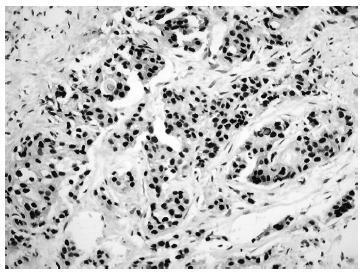Summary
Revista Brasileira de Ginecologia e Obstetrícia. 2023;45(9):535-541
10-30-2023
Breast cancer (BC) biomarkers, such as hormone receptors expression, are crucial to guide therapy in BC patients. Antiandrogens have been studied in BC; however, limited data are available on androgen receptor (AR) expression test methodology. We aim to report the core needle biopsy (CNB) accuracy for AR expression in BC.
Patients diagnosed with stage I-III invasive BC from a single institution were included. Androgen receptor expression was evaluated by immunohistochemistry (IHC) using 1 and 10% cutoff and the AR expression in surgical specimens (SS) was the gold standard. Kappa coefficients were used to evaluate the intraprocedural agreement.
A total of 72 patients were included, with a mean age of 61 years old and 84% were Luminal A or B tumors. The prevalence of AR expression in all BC samples was 87.5% using a cutoff ≥ 10% in SS. With a cutoff value ≥ 1%, CNB had an accuracy of 95.8% (Kappa value = 0.645; 95% confidence interval [CI]: 0.272–1.000; p < 0.001) and 86.1% (Kappa value = 0.365; 95% CI: 0.052–0.679; p < 0.001) when ≥ 10% cutoff was used for AR positivity. Androgen receptor expression in CNB (cutoff ≥ 1%) had a sensitivity of 98.5%, specificity of 60%, positive predictive value of 97.0%, and a negative predictive value of 76.9% in the detection of AR expression in SS.
Core needle biopsy has good accuracy in evaluating AR expression in BC. The accuracy of CNB decreases with higher cutoff values for AR positivity.
Summary
Revista Brasileira de Ginecologia e Obstetrícia. 2021;43(9):710-712
11-29-2021
With the widespread uptake of noninvasive prenatal testing (NIPT), a larger cohort of women has access to fetal chromosomal sex, which increases the potential to identify prenatal sex discordance. The prenatal diagnosis of androgen insensitivity syndrome (AIS) is an incidental and rare finding. We wish to present the diagnosis of a prenatal index case after NIPT of cell-free fetal DNA and mismatch between fetal sex and ultrasound phenotype. In this particular case, the molecular analysis of the androgen receptor (AR) gene showed the presence of a pathogenic mutation, not previously reported, consistent with complete androgen insensitivity syndrome. Carrier testing for the mother revealed the presence of the same variant, confirming maternal hemizygous inheritance. Identification of the molecular basis of these genetic conditions enables the preimplantation or prenatal diagnosis in future pregnancies.
Summary
Revista Brasileira de Ginecologia e Obstetrícia. 2016;38(10):512-517
10-01-2016
Triple-negative breast carcinomas (TNBCs) represent a heterogeneous group of neoplasias, even though they generally exhibit a clinically more aggressive phenotype, and are more prevalent in young women. To date, targeted therapies for this group of tumors have not been defined. The aim of this study was to evaluate the frequency of the apocrine subtype in TBNCs from premenopausal patients as defined by the immunohistochemical expression of the androgen receptor (AR) and its association with: histological type; tumor grade; proliferative activity; epidermal growth factor receptor (EGFR) expression; and a basal-like phenotype.
A total of 118 tumor samples from patients aged 45 years or younger were selected and reviewed according to histological type and grade. Ki-67 expression was also evaluated. Immunohistochemical expression of the AR, basal cytokeratin ⅚, and EGFR expression were analyzed in tissue microarrays. The apocrine subset was defined by AR-positive expression. The basal-like phenotype was characterized by cytokeratin ⅚ and/or EGFR expression.
An apocrine profile was identified in 6/118 (5.1%) cases. This subset of cases also exhibited a lower rate of Ki-67 expression (17.5% versus 70.0%, p= 0.02), and a trend toward a lower histological grade (66.7% versus 27.9%, p= 0.06).
The apocrine subtype of TNBCs is rare among premenopausal women, and it tends to present as carcinomas of lower grade and lower proliferative activity, suggesting a less aggressive biological phenotype.
